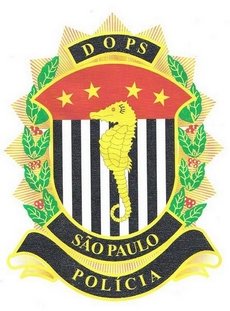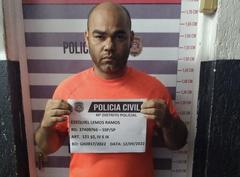
Polícia Civil do Estado de São Paulo: Visiting Hours, Tickets, and Historical Significance
Date: 14/06/2025
Introduction
Visiting the Polícia Civil do Estado de São Paulo (PCESP) offers an exceptional opportunity to explore one of Brazil’s most historically significant law enforcement institutions. With origins dating back to the early 19th century, the PCESP has played a pivotal role in criminal investigations and judicial support across the state. This guide provides a comprehensive overview of its historical trajectory, institutional structure, and practical visitor information, including details on the renowned Museu da Polícia Civil. Whether you are a resident, tourist, student, or researcher, understanding the evolution and current functions of the PCESP enhances your engagement with this vital component of São Paulo’s public security landscape.
Table of Contents
- Introduction
- Historical Origins of the Polícia Civil in São Paulo
- Institutional Development and Legal Framework
- Hierarchical Structure and Careers
- Modernization and Institutional Challenges
- Visiting the Museu da Polícia Civil de São Paulo
- Nearby Historical Attractions and Cultural Tourism
- Practical Visitor Guide: Headquarters and Services
- Frequently Asked Questions (FAQ)
- Key Takeaways and Travel Tips
- References
Historical Origins of the Polícia Civil in São Paulo
The Polícia Civil’s roots are deeply intertwined with the broader evolution of Brazil’s judicial police, tracing back to the 17th century. Early law enforcement in colonial Brazil involved alcaides and criminal ministers maintaining order, with the support of scriveners who documented legal proceedings. The establishment of the Intendência Geral de Polícia da Corte e do Estado do Brasil in Rio de Janeiro in 1808 by D. João VI marked a foundational moment for the country’s police system, setting a structural precedent for future developments (Wikipedia).
In São Paulo, the police structure solidified throughout the 19th century, especially after the 1866 Imperial Decree No. 3.598, which separated civil and military police functions. The proclamation of the Republic led to the replacement of the urban guard with the Guarda Civil, a direct precursor to the modern Polícia Civil (Wikipedia).
Institutional Development and Legal Framework
The modern institutionalization of the Polícia Civil in São Paulo was formalized by Lei Complementar nº 207, de 1979, which defined its structure, careers, and operational principles (Lei Complementar 207/1979). The 1988 Federal Constitution further cemented the PCESP as the state judicial police authority, responsible for criminal investigations and supporting the judiciary.
Recent legal reforms, such as Lei Complementar nº 106/2023, have focused on modernizing and enhancing professional recognition within the institution (Propositura Alesp).
Hierarchical Structure and Careers
Entry into the PCESP is via competitive public examination, with higher education required for most positions. The main careers include:
- Delegado de Polícia: Bachelor’s in Law with at least two years’ experience in legal or police activities.
- Médico Legista & Perito Criminal: Specialized higher education relevant to forensic roles.
- Escrivão, Investigador, Papiloscopista, Agente de Telecomunicação: Higher education required.
- Agente Policial: Unified position with standardized remuneration (Propositura Alesp).
Career progression spans five classes, with top-tier agents earning over R$ 24,000 monthly.
Modernization and Institutional Challenges
Despite significant advancements, the PCESP faces ongoing challenges, including staffing shortages and salary competitiveness. While São Paulo is Brazil’s economic powerhouse, its police salaries are only average compared to other states, prompting discussions on professional recognition (SINDPESP).
The passage of the new Lei Orgânica Nacional das Polícias Civis (Lei nº 14.735/2023) and legislative debates reflect efforts to increase institutional efficiency and autonomy (SINDPESP).
Visiting the Museu da Polícia Civil de São Paulo
Practical Information for Visitors
- Address: Museu da Polícia Civil, Academia de Polícia “Dr. Coriolano Nogueira Cobra” (Acadepol), Praça Professor Reynaldo Porchat, 219 – Butantã, São Paulo/SP.
- Hours: Tuesday to Friday, 9:00 AM – 5:00 PM; Saturday, 10:00 AM – 4:00 PM; closed Sundays and public holidays.
- Admission: Free. Group/guided visits require advance booking.
- Accessibility: Ramps and elevators available; contact museum for specific needs.
- Official Website: Museu da Polícia Civil São Paulo
Museum Highlights and Visitor Tips
The museum houses over 3,000 artifacts, including historic police vehicles, weapons, archives from notable cases (like the “Crime da Mala” and “Chico Picadinho”), and reconstructions of vintage police offices. Temporary exhibitions, seminars, and workshops contribute to a dynamic visitor experience.
Tips for Visitors:
- Book guided tours in advance for a richer educational experience.
- Photography is permitted in most areas, but some exhibits may have restrictions.
- Bring identification for entry and comply with security procedures.
- Combine your visit with other Butantã district attractions.
Nearby Historical Attractions and Cultural Tourism
Enhance your visit by exploring neighboring sites:
- Museu do Ipiranga: Key site of Brazil’s independence.
- Pinacoteca do Estado: Premier art museum with significant collections.
- Centro Histórico de São Paulo: Landmarks, churches, and cultural institutions.
Practical Visitor Guide: Headquarters and Police Services
Main Headquarters Location
- Palácio da Polícia Civil: Rua Brigadeiro Tobias, 527 – Luz, São Paulo – SP, 01032-000, Brazil. Accessible via Luz metro/train station.
Police Services for the Public
- Police Stations: Open 24/7, especially in central areas. Administrative offices operate Monday to Friday, 9:00 AM – 6:00 PM.
- Online Reporting: Non-urgent cases (e.g., lost documents) can be registered via the Delegacia Eletrônica.
- For Tourists: No entrance fee or ticket required. Bring a translator or translation app if needed.
Required Documents:
- ID/passport
- Detailed incident report
- Supporting materials (photos, receipts)
Security Procedures:
- Expect screenings and waiting times.
- Photography is prohibited within police precincts.
Frequently Asked Questions (FAQ)
Q: Is the Museu da Polícia Civil accessible for people with disabilities?
A: Yes, ramps and elevators are available. Contact the museum ahead for special arrangements.
Q: Are guided tours available at the museum?
A: Yes, for groups and educational institutions by advance booking.
Q: What are the main visiting hours for police stations and the museum?
A: Police stations: 24/7. Museum: Tuesday–Friday 9 AM–5 PM, Saturday 10 AM–4 PM.
Q: Can tourists report crimes online?
A: Yes, through the Delegacia Eletrônica platform.
Q: Is there a ticket fee for the museum or police services?
A: No, both are free of charge.
Key Takeaways and Travel Tips
- The Polícia Civil do Estado de São Paulo is a cornerstone of public security and a fascinating subject for visitors interested in law enforcement history.
- The Museu da Polícia Civil offers a rich, accessible educational experience and is ideal for combining with other cultural attractions in São Paulo.
- For official police services, familiarize yourself with operational hours, required documents, and institutional protocols.
- Use official online resources and, if needed, seek assistance from your consulate.
References
- SINDPESP
- Polícia Civil do Estado de São Paulo
- Museu da Polícia Civil São Paulo
- Lei Complementar 207/1979
- Propositura Alesp
- Delegacia Eletrônica
- Wikipedia: Polícias Civis do Brasil
For image selection: prioritize photos of the Museu da Polícia Civil’s exhibits, the Palácio da Polícia Civil headquarters, and nearby cultural sites. Use descriptive alt text such as “Museu da Polícia Civil de São Paulo exhibit” and “São Paulo police headquarters Luz.”





































































































































































